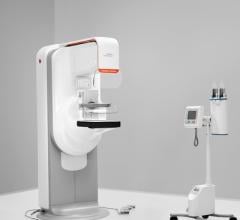
May 15, 2019 — High negative predictive values (NPV) in mammography architectural distortion (AD) without ultrasonographic (US) correlate or magnetic resonance imaging (MRI) enhancement suggests follow-up rather than biopsy may be safely performed, according to a new study. The study was presented at the American Roentgen Ray Society (ARRS) 2019 Annual Meeting, May 5-10 in Honolulu.
Management of MG-detected AD varies among practices when tomosynthesis-guided biopsy is not available. The study was conducted to evaluate outcomes of architectural distortion on mammography (MG) with or without a magnetic resonance (MR) correlate.
Unexplained architectural distortion on MG cases with subsequent MR were retrospectively reviewed by MG type, biopsy type and cancer results, cancer type, tumor grade and receptor status. Among the study group of 57 patients, the negative predictive value of MG AD without MR correlate or enhancement was 97.2 percent. Forty-four of 57 had MG AD without US correlate. Of 12 patients without US but with MR correlate, cancers (25 percent) were masses on MR, majority of benign findings (58.3 percent) were nonmass enhancement (NME), and RS/CSL (41.7 percent) was mass or NME. No MG AD without US or MR correlate was found to be cancer. The NPV of MG AD without US or MR correlate or enhancement was 100 percent.
The results indicate that follow-up rather than biopsy may be safely performed in cases of MG AD without US and MRI correlate or enhancement, reducing the need for intervention and lowering healthcare costs.
"With 3-D tomosynthesis widely incorporated in many practices, MG AD without US or MRI correlate poses a management dilemma to radiologists," author of the study Vandana Dialani, M.D. said. "This study is especially important for institutions which do not have tomo-guided biopsy capabilities and may revert to contrast imaging as a next step in managing MG AD. Our study shows that the NPV of MG AD without US correlate or MR enhancement was 100 percent and follow-up rather than biopsy may be considered."
For more information: www.arrs.org


 December 17, 2025
December 17, 2025 









